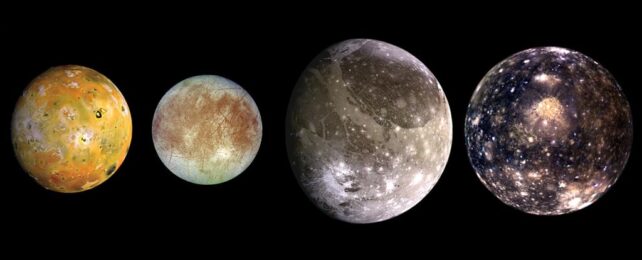A baby Jupiter, still hot from its gestation, could have blasted its four largest moons with light so intense, it vaporized water and stripped them of volatiles.
According to new research, this irradiation could explain why the Galilean moons have the compositions they do, from the hellacious volcano-world Io, closest to Jupiter, to ice-crusted Europa, then giant moon Ganymede, to the most distant, the crater-scarred Callisto.
These four moons follow two composition gradients: the farther they get from Jupiter, the lower their density and the higher their proportion of water ice. Callisto, the most heavily cratered body in the Solar System, is roughly half rock and half ice, while Io has the least ice of any body in the Solar System.
A team of astronomers led by planetary scientist Carver Bierson of Arizona State University has presented its findings at the 54th Lunar and Planetary Science Conference.
Astronomers believe when Jupiter was in its final stages of formation, it slurped up the last bit of material from the disk of gas and dust that once surrounded it. The Galilean moons, arrayed around the Jovian equator, are thought to have formed from this disk, like a planetary system in miniature. When the disk had dissipated, the newly formed Jupiter shone intensely – more than 10,000 times brighter than it glows today.
That's still not nearly as bright as a star, but it's bright enough that the two innermost Galilean moons, Io and Europa, would have bit showered with radiation from Jupiter an order of magnitude more intense than the light received from the Sun.
Bierson and his colleagues conducted computer modeling to determine the effect this irradiation would have had on the baby moons, assuming that Io – now the most volcanic body in the Solar System – once had a significant amount of water ice after it had finished forming.
The team also used the current positions of the Galilean moons with respect to Jupiter, even though they were probably closer to the planet billions of years ago. This means that the amount of radiation in which they were bathed was probably higher than the models found, which could mean that the effects of that radiation occurred more quickly in reality.
"We find," they write in their conference paper, "that during the first few million years after its formation, Io could have had equilibrium temperatures in excess of 300 Kelvin (26.85 degrees Celsius, or 80.33 degrees Fahrenheit) due to Jovian radiation."
This doesn't sound very hot – it would be a lovely balmy day, here on Earth – but it would be sufficient to melt any surface ice, producing significant oceans that would, in turn, generate an atmosphere of water vapor.
Even today, Io can't hold onto gasses in its atmosphere, produced by its prolific volcanic activity. They rapidly leak out into space, feeding into a ring of plasma that encircles Jupiter, ultimately feeding down to the gas giant and contributing to its permanent ultraviolet aurorae. Back when the moon had just formed, atmospheric escape would have occurred the same way, leaking that water vapor out into space, leaving Io more parched than anything else in the Solar System.
The effect on Europa would have been smaller than that observed for Io, leaving behind enough for a global surface ocean and its thick covering of ice. Unbelievably, that ocean is a puddle today compared to what it once had, with a large proportion of its original water lost to Jupiter's early glow.
Ganymede and Callisto, the most distant Galilean moons from Jupiter, have roughly similar percentages of ice and rock; they would have remained largely unaffected by the early irradiation, and any changes between them would have been the result of differences in their subsequent evolution.
The findings, Bierson and his colleagues believe, offer a tidy and plausible explanation for the strange compositional differences between the four Galilean moons, which are thought to have formed from the same cloud of dust circling Jupiter.
"The volatile inventories we see at the Galilean satellite today could be the result of one strong process, or many acting in concert," the researchers conclude.
"In this work we find that heating from Jupiter could have removed any water inventory at Io in its first few million years if it was present … Overall we show that this is a process that should be considered when others struggle to explain the observed density gradient."
The research was presented at the 54th Lunar and Planetary Science Conference.
